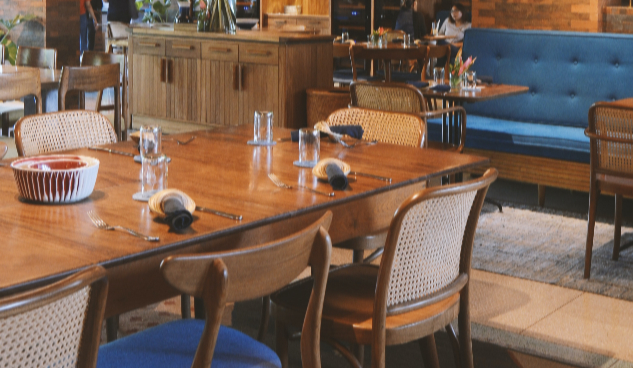


The $28.6 billion Restaurant Revitalization Fund (RFF) for restaurants, bars, caterers, and other food businesses will open Monday (May 3). RFF, which was authorized by the March stimulus bill, will offer grants of up to $10 million to replace lost sales.
Program details
The American Rescue Plan Act established the Restaurant Revitalization Fund (RRF) to provide funding to help restaurants and other eligible businesses keep their doors open. This program will provide restaurants with funding equal to their pandemic-related revenue loss up to $10 million per business and no more than $5 million per physical location. Recipients are not required to repay the funding as long as funds are used for eligible uses no later than March 11, 2023.
Who is eligible for RRF grants?
Eligible entities who have experienced pandemic-related revenue loss include:
- Restaurants
- Food stands, food trucks, food carts
- Caterers
- Bars, saloons, lounges, taverns
- Snack and nonalcoholic beverage bars
- Bakeries (onsite sales to the public comprise at least 33% of gross receipts)
- Brewpubs, tasting rooms, taprooms (onsite sales to the public comprise at least 33% of gross receipts)
- Breweries and/or microbreweries (onsite sales to the public comprise at least 33% of gross receipts)
- Wineries and distilleries (onsite sales to the public comprise at least 33% of gross receipts)
- Inns (onsite sales of food and beverage to the public comprise at least 33% of gross receipts)
- Licensed facilities or premises of a beverage alcohol producer where the public may taste, sample, or purchase products
How and when can you apply?
- You can apply through SBA-recognized https://restaurants.sba.gov application portal on Friday, 30 April. The Small Business Administration (SBA) will begin to accept applications on Monday, May 3.
- Registration with SAM.gov is not required. DUNS or CAGE identifiers are also not required.
- If you would like to prepare your application, view the sample application form. You will be able to complete this form online. Please do not submit RRF forms to SBA at this time.
- SBA Form 3172
Additional Documentation required:
Verification for Tax Information: IRS Form 4506-T, completed and signed by Applicant. Completion of this form digitally on the SBA platform will satisfy this requirement.
- Gross Receipts Documentation: Any of the following documents demonstrating gross receipts and, if applicable, eligible expenses
- Business tax returns (IRS Form 1120 or IRS 1120-S)
- IRS Forms 1040 Schedule C; IRS Forms 1040 Schedule F
- For a partnership: partnership’s IRS Form 1065 (including K-1s)
- Bank statements
- Externally or internally prepared financial statements such as Income Statements or Profit and Loss Statements
- Point of sale report(s), including IRS Form 1099-K
For applicants that are a brewpub, tasting room, taproom, brewery, winery, distillery, or bakery:
- Documents evidencing that onsite sales to the public comprise at least 33.00% of gross receipts for 2019, which may include Tax and Trade Bureau (TTB) Forms 5130.9 or TTB. For businesses who opened in 2020, the Applicant’s original business model should have contemplated at least 33.00% of gross receipts in onsite sales to the public.
For applicants that are an inn:
- Documents evidence that onsite sales of food and beverage to the public comprise at least 33.00% of gross receipts for 2019. For businesses that opened in 2020, the Applicant’s original business model should have contemplated at least 33.00% of gross receipts in onsite sales to the public.
Set asides
- $5 billion is set aside for applicants with 2019 gross receipts of not more than $500,000
- An additional $4 billion is set aside for applicants with 2019 gross receipts from $500,001 to $1,500,000
- An additional $500 million is set aside for applicants with 2019 gross receipts of not more than $50,000
*SBA reserves the right to reallocate these funds at the discretion of the Administrator.
Funding amount
Payment calculations
Calculation 1: for applicants in operation before or on January 1, 2019:
- 2019 gross receipts minus 2020 gross receipts minus PPP loan amounts
Calculation 2: for applicants that began operations partially through 2019:
- (Average 2019 monthly gross receipts x 12) minus 2020 gross receipts minus PPP loan amounts
Calculation 3: for applicants that began operations on or between January 1, 2020 and March 10, 2021 and applicants not yet opened but have incurred eligible expenses:
- Amount spent on eligible expenses between February 15, 2020 and March 11, 2021 minus 2020 gross receipts minus 2021 gross receipts (through March 11, 2021) minus PPP loan amounts
For those entities who began operations partially through 2019, you may elect (at your own discretion) to use either calculation 2 or calculation 3.
Maximum and minimum amounts
SBA may provide funding up to $5 million per location, not to exceed $10 million total for the applicant and any affiliated businesses. The minimum award is $1,000.
Gross receipts
For the purposes of this program, gross receipts does not include:
- Amounts received from Paycheck Protection Program (PPP) loans (First Draw or Second Draw)
- Amounts received from Economic Injury Disaster Loans (EIDL)
- Advances on EIDL (EIDL Advance and Targeted EIDL Advance)
- State and local grants (via CARES Act or otherwise)
- SBA Section 1112 payments



Allowable use of funds
Funds may be used for specific expenses including:
- Business payroll costs (including sick leave)
- Payments on any business mortgage obligation
- Business rent payments (note: this does not include prepayment of rent)
- Business debt service (both principal and interest; note: this does not include any prepayment of principal or interest)
- Business utility payments
- Business maintenance expenses
- Construction of outdoor seating
- Business supplies (including protective equipment and cleaning materials)
- Business Food and beverage expenses (including raw materials)
- Covered supplier costs
- Business operating expenses